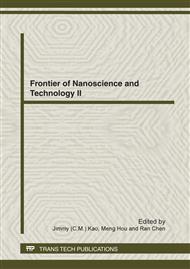p.237
p.241
p.245
p.249
p.254
p.259
p.263
p.267
p.272
Numerical and Experimental Study on Fabrication of Microstructure Array with Topographical Gradient via Through-Mask EMM
Abstract:
To obtain textured surface with low friction and high fluid load support capacity, in this work, based on the basic tenet of fluid film lubrication theory that converging gap is the first necessary condition to generate a hydrodynamic pressure in a confined fluid film, a fabrication method via through-mask electrochemical micromachining (EMM) for microstructure array on metal substrate with topographical gradient in a single micromachining step is investigated. After analyzing the factors that influence the current density distribution on the anode surface in EMM process, three potentially feasible schemes are presented and their fabrication results are predicted through numerical simulation. Combining the simulation results with practical application requirements, the scheme with machining gap gradient is adopted. With the selected fabrication scheme, the experiments are performed and the microstructure array with a feature size of 25μm and a height variance from 12μm to 24μm within 2mm distance has been produced successfully, which is in good agreement with the numerical calculation prediction.
Info:
Periodical:
Pages:
254-258
Citation:
Online since:
June 2012
Authors:
Price:
Сopyright:
© 2012 Trans Tech Publications Ltd. All Rights Reserved
Share:
Citation:


